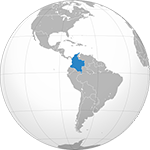Overview
Three years after the signing of the Peace Agreement between the Government and the Revolutionary Armed Forces of Colombia (FARC), Colombia continues to face multiple challenges. In 2020, at least 5.1 million people are estimated to need humanitarian assistance. The escalation of conflict, particularly in isolated rural areas, natural disasters, and the arrival of refugees and migrants are some of the factors that add to existing needs. The most affected departments are La Guajira, Norte de Santander, Arauca, Córdoba, Choco, Nariño, Putumayo, Guaviare.?
There has been a fragmentation of armed groups and drug cartels seeking greater territorial control in strategic areas. The increased violence, especially in rural areas, creates significant protection concerns. In 2019, some 35,300 people were internally displaced, more than 27,600 people suffered severe movement restrictions, and the use of anti-personnel mines increased. Confinement, threats, or armed curfews cause problems in safe access to education, health, and water collection activities for entire communities. These events are now taking place in areas previously unaffected by the conflict. Afro-Colombians and indigenous communities continue to be disproportionally affected by the conflict, and social leaders have become systematic targets of violent attacks.?
In addition, in 2019 there were 1.7 million Venezuelan migrants and refugees in Colombia, another 500,000 people transited through the country, and 500,000 Colombians returned from Venezuela. The impact of the arrival and transit of millions of people has been considerable on services and resources. ?
INFORM measures Colombia's risk of humanitarian crisis and disaster for 2020 as High at 5.4/10. Hazard and exposure as well as vulnerability are a particular concern, at 6.9/10 and 6.1/10. ?
Latest Developments
Latin America and the Caribbean have become the global epicentre of the COVID-19 pandemic, according to the World Health Organization. Measures taken to contain virus spread in the region are having negative impacts on the population. The regional economy is forecast to have its biggest contraction ever, particularly affecting those who work in the informal sector. As a result, the World Food Programme estimates that food insecurity across the region in 2020 will likely increase from the current 3.4 million to 13.7 million. In Haiti, the number of people in severe food insecurity is projected to rise from 700,000 to 1.6 million. In the Northern Triangle (Guatemala, El Salvador, Honduras), the number of people affected by severe food insecurity is projected to increase from 1.6 million up to 3 million. The number of vulnerable Venezuelan migrants and refugees experiencing severe food insecurity in Colombia, Ecuador, and Peru is expected to increase from 540,000 to more than 1 million.?
ACAPS' team is daily monitoring the impact of the COVID-19 pandemic. For more information related to the outbreak in Colombia, see content below.
Key Figures
INFORM Global Crisis Severity Index
Crisis Severity: 3.4
Impact: 4.1
Humanitarian Conditions: 3
Complexity: 3.5
Access Constraints: 3
Information courtesy of ACAPS. https://www.acaps.org/
Key Figures - 2019 HPC
in need
reached
Objectives
- To promote and implement actions in terms of temporary accommodation/shelter solutions for people displaced by disasters of natural and/or anthropogenic origin (widespread violence) and/or the Colombian population affected by the migratory crisis, which guarantee a healthy and safe environment in conditions of dignity and privacy.
- To strengthen the capacities for the preparation and response of the key actors (at a governmental level,LCT, civil society and other coordination mechanisms) of the territories prioritized in temporary accommod
- Support for early recovery and lasting solutions in terms of accommodation, educational facilities and community infrastructure ensuring a healthy and safe environment in conditions of dignity and privacy.
| Title | Posted on |
|---|---|
| Flash Update No. 6 COVID 19 - Putumayo | 27 Jun 2020 |
| Flash Update No.4 - COVID-19 en Chocó - Junio 2020 | 26 Jun 2020 |
| Reunión Clúster SAN | 24 Jun 2020 |
| Reunión Clúster SAN | 24 Jun 2020 |
| Reunión Clúster SAN | 24 Jun 2020 |
26 Common Operating Datasets or CCCM-tagged datsets are on the Humanitarian Data Exchange:
- Iraq Displacement Data - IDPs [IOM DTM] - International Organization for Migration (IOM) - 03/01/2020-04/29/2020
- Iraq Returnee Data [IOM DTM] - International Organization for Migration (IOM) - 03/01/2020-04/29/2020
- Iraq IDP Camp Profiling Data, round VI (Aug-Sept 2016) - REACH & CCCM Cluster - 08/17/2016-09/19/2016
- South and central Iraq - profiling exercise - Ministry of Displacement and Migration (MoDM) Iraq, UNHCR Iraq - 05/01/2016-10/31/2016
- Iraq - Standard naming, GPS coordinates and P-codes for IDP Camps - CCCM 3w mapping and partners reports - 11/24/2014

